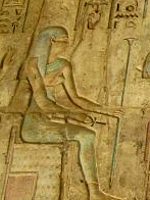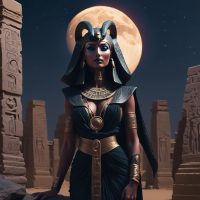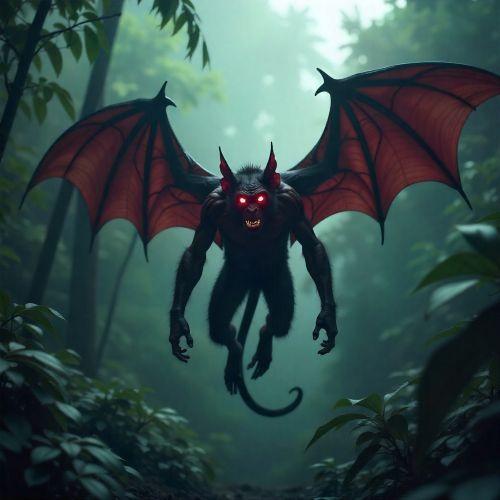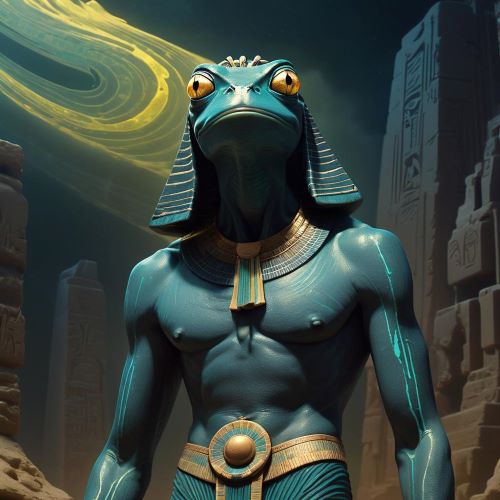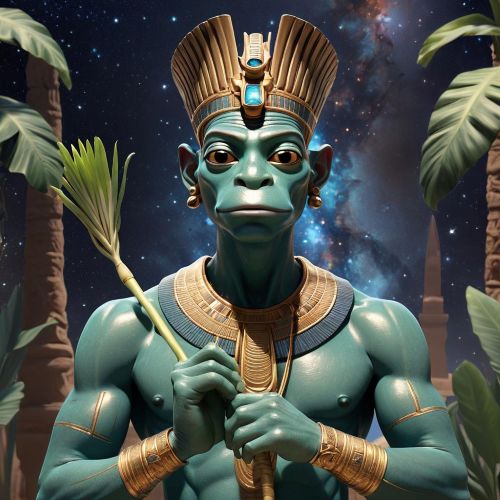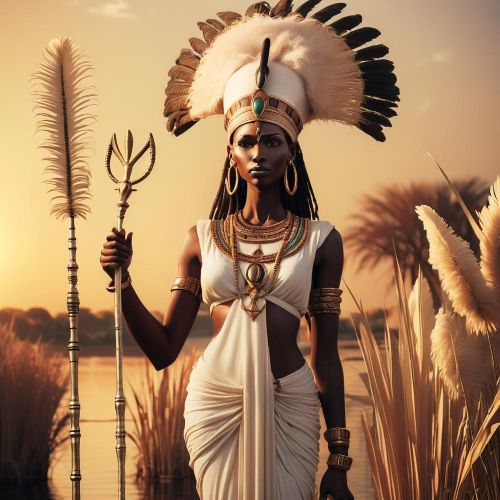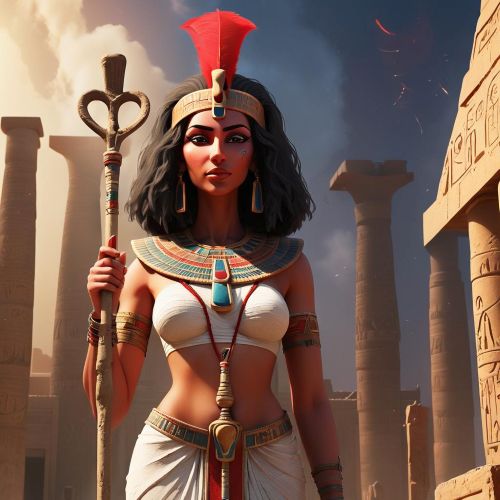Kauket : Goddess of Darkness
Listen
At a glance
| Description | |
|---|---|
| Origin | Egyptian Mythology |
| Classification | Gods |
| Family Members | Kek (Husband) |
| Region | Egypt |
| Associated With | Darkness, Chaos, Night |
Kauket
Introduction
In Egyptian mythology, Kauket—also known as Keket or Kuket—is the goddess of darkness, representing the mysterious and unseen aspects of existence before the creation of the world. She belongs to the Ogdoad, a group of eight primordial deities worshipped in Hermopolis (Khmunu), who personified the chaotic forces that preceded cosmic order. Alongside her male counterpart Kek, she embodies the feminine aspect of darkness and obscurity, forming part of the dualistic structure of Egyptian cosmology. The Ogdoad described the elements that existed before the world was formed—water, air, darkness, and infinity—each represented by a male and female pair. Kauket and Kek specifically symbolized the primordial darkness that enveloped the universe before light was born. Though she was not a major temple goddess, her role as the embodiment of darkness was central to Egypt’s understanding of balance and creation, where chaos and order coexisted as necessary cosmic forces.
Physical Traits
Kauket was most commonly depicted as a snake-headed woman, a form that symbolized her connection to transformation, regeneration, and the unseen powers of the earth. The serpent in Egyptian iconography was a dual symbol—both dangerous and protective, deadly yet regenerative—reflecting the nature of darkness as both fearful and fertile. In some depictions, Kauket appeared as a full serpent, reinforcing her association with the chthonic realms of night and the underworld. The snake’s ability to shed its skin mirrored the cyclical movement of darkness giving way to dawn.
Her male counterpart Kek was depicted as a frog-headed man, linking him to the water and fertility of the primordial abyss. The pairing of serpent and frog was deliberate—it illustrated the Egyptian idea that creation arose from the union of complementary forces. The female serpent’s still, coiled energy represented the hidden potential within darkness, while the male frog’s leap signified emergence and activity. Kauket’s iconography thus reflected her role in maintaining balance between dormancy and awakening, concealment and revelation.
Family
Kauket was part of the Ogdoad, which consisted of four divine pairs: Nun and Naunet (water), Heh and Hauhet (infinity), Amun and Amaunet (hiddenness), and Kek and Kauket (darkness). Each pair represented male and female aspects of the same concept, reinforcing the Egyptian view that creation stemmed from harmony between masculine and feminine principles. Together, these deities dwelled in the primordial waters of Nun, the endless void that existed before the birth of the sun.
According to the Hermopolitan creation myth, the Ogdoad collectively brought forth the first light. From their chaotic union emerged a lotus flower that rose from the waters, opening to reveal the sun god Ra, the first act of creation. After this, the Ogdoad retreated to the depths, continuing to maintain the natural balance of light and darkness. In some esoteric interpretations, Kauket and Kek are also seen as guardians who accompany Ra on his nightly journey through the Duat (underworld), guiding him safely from dusk to dawn.
Other names
Kauket’s name originates from the Egyptian word kkw, meaning “darkness” or “obscurity.” Variations such as Keket or Kuket appear in different regional and temporal contexts, reflecting changes in pronunciation and writing conventions. Her name’s root also connects her closely with Kek, emphasizing their inseparability as two halves of the same primordial concept. In religious hymns and temple texts, she was occasionally called the “Bringer-in of the Night”, while Kek was referred to as the “Bringer-in of the Day.”
This naming structure reflected the Egyptians’ cyclical understanding of time and balance—darkness was not merely the absence of light, but its complement. Hieroglyphic representations of her name combined symbols of the sky and darkness with divine determinatives, emphasizing her celestial and eternal essence. Unlike later solar deities, Kauket’s name was never associated with evil; rather, it denoted mystery, stillness, and the fertile potential hidden in shadow.
Powers and Abilities
Kauket’s powers were more philosophical and cosmic than personal or mythological. As the embodiment of primordial darkness, she governed the hidden spaces of creation and the transitions between day and night. Darkness, in Egyptian cosmology, was not a force of destruction but of incubation—it was within this infinite shadow that all life first stirred. Kauket’s influence thus extended to the realms of transformation, rebirth, and balance.
She was believed to preside over the evening twilight, symbolizing the moment of descent from light into shadow, just as Kek presided over the dawn. Together, they ensured the eternal rhythm of night following day and day returning after night, sustaining the cosmic equilibrium. Some mythological interpretations suggest that Kauket helped guide the sun god Ra into the Duat at sunset, safeguarding his journey through the underworld until his rebirth at dawn.
Spiritually, Kauket represented the unseen power of the subconscious—the fertile darkness where dreams, ideas, and renewal began. Her energy was that of the unknown and the potential yet to be revealed. In temple rituals and funerary texts, darkness was a necessary phase of renewal and protection, aligning with her domain. She was not a goddess of destruction, but of mystery, protection, and gestation, reminding worshippers that even in darkness, life awaited awakening.
Modern Day Influence
Although Kauket never achieved the fame of Isis or Hathor, her symbolism continues to resonate in modern times. In academic and spiritual circles, she is studied as an essential part of Egyptian cosmology’s dualistic system—where light cannot exist without darkness, and creation is born from balance, not opposition. Egyptologists interpret her presence as evidence of the Egyptians’ profound understanding of cosmic interdependence and their non-dualistic perception of good and evil.
In contemporary art and literature, Kauket has been reimagined as a symbol of feminine power, intuition, and transformation. Writers and artists exploring themes of the shadow self often draw inspiration from her as a representation of inner mystery and rebirth through darkness. In modern spirituality and goddess movements, Kauket has been invoked as an archetype for embracing the unknown, helping individuals confront fear and uncover hidden truths within themselves.
In digital and pop culture, the resurgence of her male counterpart Kek—popularized through internet memes—has indirectly brought attention to Kauket. Some reinterpretations view her as the balancing feminine energy to Kek’s chaotic symbolism, representing stillness and reflection within the creative cycle. Though these references often detach her from her original sacred context, they underscore her enduring archetypal significance as the goddess of mystery and transformation.
Today, museums and historians continue to feature Kauket and the Ogdoad in exhibitions exploring Egyptian cosmology. Her image, often as a serpent-headed goddess, reminds modern audiences of a time when darkness was not feared but revered as a necessary part of creation itself. Through her, the ancient Egyptians conveyed a timeless message—that within every shadow lies the seed of light, and in every end, a new beginning awaits.
Related Images
Source
Hill, J. (2008). Kauket. Ancient Egypt Online. Retrieved from https://ancientegyptonline.co.uk/kuaket/
Pinch, G. (2002). Handbook of Egyptian Mythology. Santa Barbara: ABC-CLIO.
Redford, D. (2002). The Ancient Gods Speak: A Guide to Egyptian Religion. Oxford University Press.
Watterson, B. (1996). The Gods of Ancient Egypt. London: Metro Books.
Wilkinson, R. H. (2003). The Complete Gods and Goddesses of Ancient Egypt. Thames & Hudson.
Wikipedia Contributors. (2024). Kek (mythology). Wikipedia. Retrieved from https://en.wikipedia.org/wiki/Kek_(mythology)[7]
Kiddle. (2025). Kuk (mythology). Retrieved from https://kids.kiddle.co/Kuk_(mythology)[1]
Pinch, G. (2002). Handbook of Egyptian Mythology. ABC-CLIO.
Assmann, J. (2001). The Search for God in Ancient Egypt. Cornell University Press.
Frequently Asked Questions
What is lorem Ipsum?
I am text block. Click edit button to change this text. Lorem ipsum dolor sit amet, consectetur adipiscing elit. Ut elit tellus, luctus nec ullamcorper mattis, pulvinar dapibus leo.
What is lorem Ipsum?
I am text block. Click edit button to change this text. Lorem ipsum dolor sit amet, consectetur adipiscing elit. Ut elit tellus, luctus nec ullamcorper mattis, pulvinar dapibus leo.
What is lorem Ipsum?
I am text block. Click edit button to change this text. Lorem ipsum dolor sit amet, consectetur adipiscing elit. Ut elit tellus, luctus nec ullamcorper mattis, pulvinar dapibus leo.
What is lorem Ipsum?
I am text block. Click edit button to change this text. Lorem ipsum dolor sit amet, consectetur adipiscing elit. Ut elit tellus, luctus nec ullamcorper mattis, pulvinar dapibus leo.
What is lorem Ipsum?
I am text block. Click edit button to change this text. Lorem ipsum dolor sit amet, consectetur adipiscing elit. Ut elit tellus, luctus nec ullamcorper mattis, pulvinar dapibus leo.


